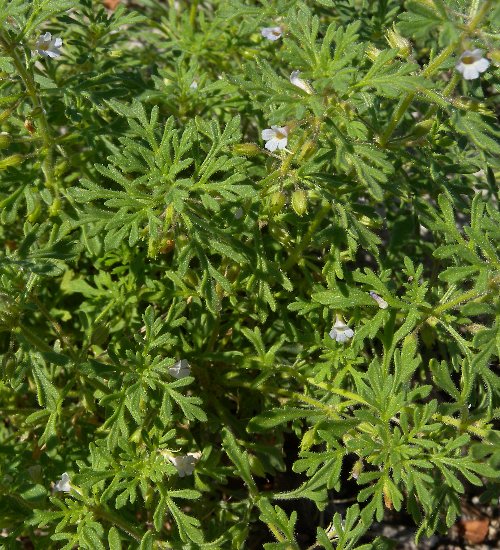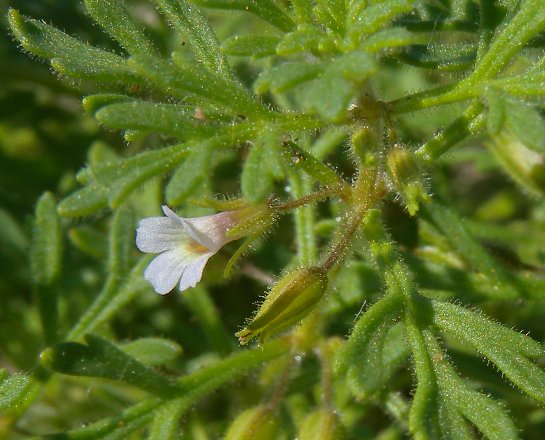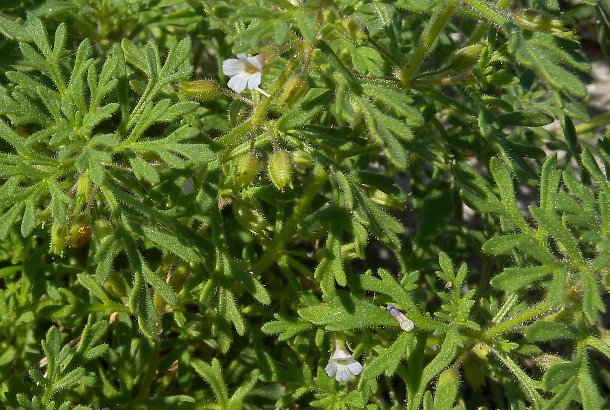Description: This plant is a summer annual about 2-8" tall and similarly across. Large plants are abundantly branched, although small plants are sometimes unbranched. The slender stems are green or reddish green, terete, and glandular-hairy. The leaves occur in opposite pairs or in whorls of 3. They are up to 1" long and ½" across, pinnately lobed, green, and glandular-hairy. Each leaf has 3-7 linear-oblong lobes and a few dentate teeth or small secondary lobes. Because of the sticky foliage, the entire plant may become brownish green if it becomes immersed in muddy water. Individual flowers are produced from the axils of the upper leaves (one flower per leaf axil).

Each flower
has a tubular corolla up to ¼" long and a calyx with
5 linear-lanceolate teeth. The corolla is pale blue-violet,
lavender, or nearly white, and weakly two-lipped. The upper lip has 1-2
shallow lobes, while the lower lip has 3 shallow lobes. There is no
nectar spur on the corolla. The calyx is green and glandular-hairy. The
pedicels are up to ¼" long, green or pale reddish green, terete, and
glandular-hairy. The
blooming period occurs from mid-summer into the fall. Individual plants
may bloom intermittently for 1-2 months, if not longer. Each flower is
replaced with an ovoid seed capsule that is about the same length as
the calyx teeth (less than ¼" in length). Each capsule contains many
tiny seeds that are light brown and dust-like. The seeds can be carried
aloft by the wind or float on water. The root system consists of a
shallow branching taproot and fibrous secondary roots. This plant
reproduces by reseeding itself.
Cultivation:
The preference is light shade to full sun, wet to moist conditions, and
soil that is muddy, sandy, gravelly, or rocky. Growth and development
occur primarily during the summer and early fall. This plant can
tolerate occasional inundation by water if it is temporary. It is
intolerant of competition from taller ground vegetation.

Range &
Habitat:
The native Obe-wan-Conobea occurs occasionally in most areas of
Illinois, except in the NW, extreme north, and some south-central
counties (see Distribution
Map). Outside of Illinois, it is found in
the Midwest and south-central states. Habitats include prairie swales,
sand and gravel bars along rivers, muddy borders of ponds, edges of
springs in wooded areas, rocky depressions in limestone
bluffs, sandy ditches, edges of mud puddles, and gravelly areas
around parking lots. This plant is often found in disturbed areas that
are partially shaded; it is also found in higher quality habitats.
Faunal Associations:
Very little is known about floral-faunal relations for this plant.
Small bees probably visit the flowers for nectar and possibly pollen.
The glandular hairs of the foliage probably deter ants from robbing the
nectar. It's possible that the tiny seeds can cling to the muddy feet
or moist feathers of waterfowl (especially ducks and geese). When the
waterfowl visit other wetlands, this would spread the seeds into new
areas.

Photographic
Location:
Gravelly ground near a parking lot at a shopping mall in Champaign,
Illinois.
Comments: This
is another small annual plant of the Figwort family that produces small
tubular flowers. Because of its diminutive size, Obe-Wan-Conobea is
easy to overlook, especially when it isn't blooming. The small annual
plants of the Figwort family occur in either dry areas or wetlands
where there is scant or low ground vegetation. Obe-Wan-Conobea is found
in wetlands or moist wooded areas. It differs from other plants in this
group by its pinnately lobed leaves, which are sometimes whorled. This
makes Obe-Wan-Conobea relatively easy to identify. The derivation of
the strange common name comes from a publication of Floyd Swink, who
named this plant after a character in the movie Star Wars, although the
publisher did not discover this until after his book was already
published (John White, personal communication). Another common name for
this plant is Narrow-Leaved Paleseed, which was undoubtedly invented by
a botanist. A scientific synonym for this species is Conobea
multifida.